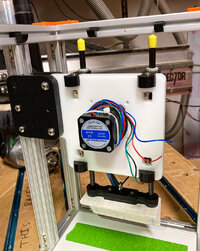hydrophyte
Member
- Joined
- 22 Aug 2009
- Messages
- 1,073
Plastic Beach - Water Wave Machine
I've been pondering this idea for a while and I've finally put together a design for experimentation. My goal is a machine to create traveling waves in an aquarium like wind-driven waves in a natural body of water. These differ from the kind of water movement generated by reef aquarium wavemakers as they would have rhythmic crests & troughs and directional movement down the length of the enclosure.
With a search you can find several videos with machines achieving this for educational and scientific purposes, or just for fun. But none of the ones I have seen really integrated the concept as a display aquarium with livestock, plants and other ecosystem features.
Here is a really interesting video from MIT with clips showing sand ripple development in a large wave tank...
YouTube: Dynamics of Wave Ripples
Most of the examples I have seen used a hinged paddle at one end of the enclosure and actuated with a servo motor or other mechanism. For my project I wish to make the most efficient use of the limited lengthwise space in a glass tank, while also designing the machine as an appealing kind of kinetic sculpture. So I opted instead for a cam & follower mechanism with a stepper motor supplying power. Here's the whole deal in operation with the 6-gallon bookshelf tank...

Here's another example with a wave machine that works in a similar way with a wedge-shaped paddle...
YouTube: Miniature wave tank
I have an idea in mind for a sloping 3D-printed beach to break the waves at the tank far end, but for now I've just piled up these lava rocks. They work OK. Without some kind of physical dissipation, the energy will just bounce back to the middle of the tank to create standing waves...

There are some cool ideas to explore with wave height, length, frequency and other parameters. I have this microcontroller + stepper driver set up with a rotary encoder and LCD display to toggle the motor on & off and control other signals. Luckily I got some help with this because I'm really not great with code and electronics...would have otherwise taken me forever to figure out...

I'm going to run this for a week or so and then design a version 2.0 with smoother operation (I hope) and nicer fit & finish. This is most likely going to be a brackish water system with moderate salinity and appropriate organisms. I'll explain some more of that later on as I get it organized.
I've been pondering this idea for a while and I've finally put together a design for experimentation. My goal is a machine to create traveling waves in an aquarium like wind-driven waves in a natural body of water. These differ from the kind of water movement generated by reef aquarium wavemakers as they would have rhythmic crests & troughs and directional movement down the length of the enclosure.
With a search you can find several videos with machines achieving this for educational and scientific purposes, or just for fun. But none of the ones I have seen really integrated the concept as a display aquarium with livestock, plants and other ecosystem features.
Here is a really interesting video from MIT with clips showing sand ripple development in a large wave tank...
YouTube: Dynamics of Wave Ripples
Most of the examples I have seen used a hinged paddle at one end of the enclosure and actuated with a servo motor or other mechanism. For my project I wish to make the most efficient use of the limited lengthwise space in a glass tank, while also designing the machine as an appealing kind of kinetic sculpture. So I opted instead for a cam & follower mechanism with a stepper motor supplying power. Here's the whole deal in operation with the 6-gallon bookshelf tank...
Here's another example with a wave machine that works in a similar way with a wedge-shaped paddle...
YouTube: Miniature wave tank
I have an idea in mind for a sloping 3D-printed beach to break the waves at the tank far end, but for now I've just piled up these lava rocks. They work OK. Without some kind of physical dissipation, the energy will just bounce back to the middle of the tank to create standing waves...
There are some cool ideas to explore with wave height, length, frequency and other parameters. I have this microcontroller + stepper driver set up with a rotary encoder and LCD display to toggle the motor on & off and control other signals. Luckily I got some help with this because I'm really not great with code and electronics...would have otherwise taken me forever to figure out...
I'm going to run this for a week or so and then design a version 2.0 with smoother operation (I hope) and nicer fit & finish. This is most likely going to be a brackish water system with moderate salinity and appropriate organisms. I'll explain some more of that later on as I get it organized.








